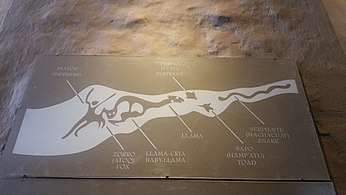Great Rift (astronomy)
In astronomy, the Great Rift (sometimes called the Dark Rift or less commonly the Dark River) are the nearby dark dust clouds that significantly obscure (extinguish) the center and most radial sectors of the Milky Way galaxy from Earth's perspective. Astronomers posit they may contain some dark matter to explain how the high rotational velocity of the arms does not result in their ejection from the galaxy and easily evinced non-luminous, molecular dust clouds. In dark, clear, dry skies the rift is as clear as the bright, saucer-shaped blur of stars which the inward-direction Milky Way appears to the eye or binoculars. The rift is largely between the Solar System (which is close to the inner edge of the Orion Arm) and the next arm, inward, the Sagittarius Arm. The clouds are an obstruction to millions of the galaxy's stars as to their detection at visible light wavelengths, a bright hazy band 30° arching through the night sky. The clouds within our radial sector of the galaxy span about 800–1,000 parsecs (2,600–3,300 ly) from Earth.[1] The clouds are estimated to contain about 1 million solar masses of plasma and dust.[2]

Properties
To the naked eye, the Great Rift appears as a dark lane that divides the bright band of the Milky Way lengthwise, through about one-third of its extent, and is flanked by lanes of numerous stars.[2] Starting at the constellation of Cygnus, where it is known as the Cygnus Rift or Northern Coalsack, the Great Rift stretches to Aquila; to Ophiuchus, where it broadens out; to Sagittarius, where it obscures the Galactic Center; essentially ending at Centaurus. One of the regions it obscures is the Cygnus OB2 association, a cluster of young stars and one of the largest regions of star formation near Earth. Similar dark rifts can be seen in many edge-on galaxies, such as NGC 891 in Andromeda and NGC 4565 (the Needle Galaxy) in Coma Berenices.[3]
Human observation

Dark zones obscuring what is in a dry atmosphere (or at long exposures) the night-sky lighting mass of the bulk of the Milky Way were recognized by many ancient civilizations in which a seasonally or regularly dry climate is frequent feature. In South America, the Inca gave some patterns of darkness and stars names much as normal stellar constellations were, including a series of animals like llamas, a fox, toad, and so on, thought to be drinking from the "great river" (the Milky Way) and seen in silhouette.[4]
The classical Greeks sometimes described the Great Rift as being the path of devastation left by Phaeton, who tried to guide the chariot of Helios (the Sun god) across the sky and lost control, wreaking havoc before being struck down by a lightning bolt of Zeus.[5]
Modern astronomy first began to notice the rift in the 18th century, but struggled to explain it until E. E. Barnard and Max Wolf in the early 20th century, who produced the currently accepted explanation after careful photographic study.[6]
Of this, Barnard said:
I did not at first believe in these dark obscuring masses. The proof was not conclusive. The increase of evidence, however, from my own photographs convinced me later, especially after investigating some of them visually, that many of these markings were not simply due to an actual want of stars but were really obscuring bodies nearer to us than the distant stars. — Astrophysical Journal (1919)

See also
- Dark-cloud constellations
- Galactic Center
- Sagittarius Star Cloud
- Serpens-Aquila Rift, a sub-feature of the Great Rift
- Emu in the sky (a continuation from Scopius to Crux)
Notes
- Green, Gregory M; Schlafly, Edward F; Finkbeiner, Douglas P; Rix, Hans-Walter; Martin, Nicolas; Burgett, William; Draper, Peter W; Flewelling, Heather; Hodapp, Klaus; Kaiser, Nicholas; Kudritzki, Rolf Peter; Magnier, Eugene; Metcalfe, Nigel; Price, Paul; Tonry, John; Wainscoat, Richard (2015). "A Three-Dimensional Map of Milky Way Dust". The Astrophysical Journal. 810 (1): 25. arXiv:1507.01005. Bibcode:2015ApJ...810...25G. doi:10.1088/0004-637X/810/1/25.
- "Great Rift: Dark area in the Milky Way". EarthSky Communications. 2010. Retrieved 2010-06-15.
- Pitts, Sam. "NGC 891 Edge on Galaxy (HV19)". Sams Astro. Archived from the original on 2008-05-13. Retrieved 2009-04-25.
- Dark Rift in the Milky Way
- The Northern Coalsack
- Paddle the Milky Way’s Dark River
References
- "The Great Rift". Encyclopædia Britannica Online. 2009. Retrieved 2009-04-25.
- "Great Rift". Sci-Tech Dictionary. Retrieved 2009-04-25.
- Kaler, Jim. "The Milky Way - From STARS". University of Illinois at Urbana-Champaign. Department of Astronomy. pp. Maps 2 and 5. Retrieved 2009-04-25.
- Dark River, Wide Field by Rogelio Bernal Andreo, at APOD